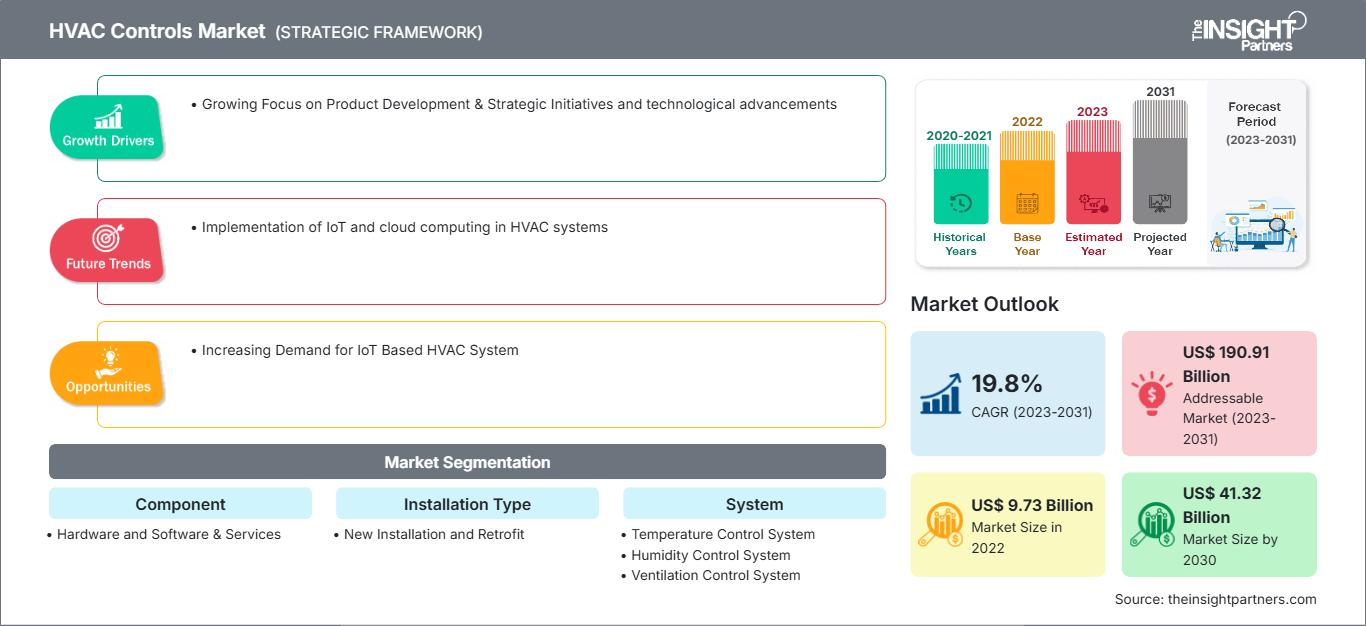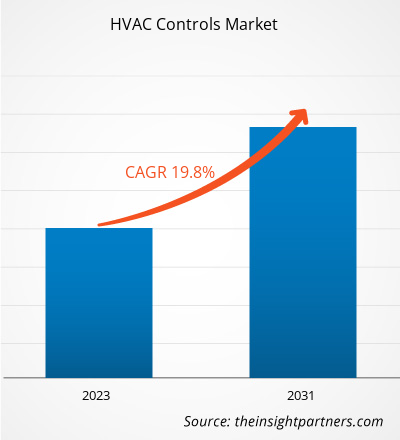The HVAC Controls market is projected to grow from US$ 9.73 billion in 2022 to US$ 41.32 billion by 2030; it is expected to expand at a CAGR of 19.8% from 2022 to 2030. Implementation of IoT and Cloud computing in HVAC systems is expected to be a key trend in the market.
HVAC Controls Market Analysis
Cloud-based HVAC control systems are quickly becoming the future of efficient and intelligent building management. These technologies, which leverage the power of the Internet and the Internet of Things (IoT), offer a new era of improved performance, lower energy usage, and unrivaled comfort. Cloud-based solutions capture real-time data on temperature, humidity, and occupancy rates. Powerful algorithms then analyze this data to improve HVAC performance. By learning usage patterns and anticipating demands, the system can automatically modify settings to provide comfort while reducing energy consumption. Thus, demand for cloud computing in HVAC systems is expected to grow during the forecast period.
HVAC Controls Market Industry Overview
HVAC stands for Heating, Ventilation, and Air Conditioning. It is a system for controlling the temperature and humidity of a space by moving air both indoors and outdoors. HVAC controllers are designed to cater to shifting environmental needs and handle even the worst-case scenarios. Several factors that influence HVAC control usage are humidity fluctuations, building occupancy, solar heat loads, and new equipment, among others. These HVAC controls are programmable, allowing for customized applications. Analog inputs in HVAC controls assess temperature, humidity, or pressure, while digital inputs control airflow based on settings like hot or cold.
Customize This Report To Suit Your Requirement
You will get customization on any report - free of charge - including parts of this report, or country-level analysis, Excel Data pack, as well as avail great offers and discounts for start-ups & universities
HVAC Controls Market: Strategic Insights

-
Get Top Key Market Trends of this report.This FREE sample will include data analysis, ranging from market trends to estimates and forecasts.
HVAC Controls Market Driver and Opportunities
Growing Focus on Product Development and Strategic Initiatives to Favor Market Growth
Increasing focus on product development and strategic initiatives are expected to drive market growth. For instance, In March 2022, Automated Logic, a subsidiary of Carrier Global Corporation, announced the addition of VAV controllers’ models OF342 and OR141 to its existing OptiFlex digital building controls line. These controllers are effective in air quality control and zone-level temperature applications. Further, in May 2022, Daikin announced its recent investment in Wlab Ltd., a startup company providing sensors for airborne allergy detection. This investment would accelerate the growth of Daikin in AC business solutions.
Increasing Demand for IoT-Based HVAC System
The increasing need for energy-efficient HVAC systems, rising replacement demand for HVAC systems, and accelerating infrastructure-based advancements are likely to fuel industry growth in the future. HVAC manufacturers are working hard to supply consumers with smart HVAC systems and grow their market share. In any commercial or residential facility, lights and HVAC systems consume the most energy. Implementing IoT in these applications and enabling machine-to-machine (M2M) connectivity is anticipated to result in cost savings, resource conservation, predictive maintenance, comfort control, and improved building performance. Thus, demand for IoT-enabled HVAC control systems is expected to grow during the forecast period.
HVAC Controls Market Report Segmentation Analysis
The key segments that contributed to the derivation of the HVAC Controls market analysis are coverage by operation, product type, substrate type, and end-use.
- Based on component, the market is divided into hardware and software & services.
- Based on installation type, the market is divided into new installation and retrofit.
- Based on the system, the market is divided into temperature control system, humidity control system, ventilation control system, and integrated control system.
- Based on end user, the market is divided into residential, commercial, and industrial.
HVAC Controls
Market Share Analysis By Geography
Based on region, the market is segmented into North America, Europe, Asia Pacific, Middle East & Africa, and South & Central America.
The North American HVAC controls industry has seen considerable expansion, driven by the need for interoperability, connectivity, network integration, data analysis, and system integration. Cloud-based HVAC systems connect easily with other smart building technologies like lighting and security. This integrated ecosystem enables more holistic building management, improving energy efficiency and creating a fully intelligent living or working environment. All these factors are expected to boost the growth of the HVAC controls market in North America during the forecast period.
HVAC Controls Market Regional InsightsThe regional trends and factors influencing the HVAC Controls Market throughout the forecast period have been thoroughly explained by the analysts at The Insight Partners. This section also discusses HVAC Controls Market segments and geography across North America, Europe, Asia Pacific, Middle East and Africa, and South and Central America.
HVAC Controls Market Report Scope
| Report Attribute | Details |
|---|---|
| Market size in 2022 | US$ 9.73 Billion |
| Market Size by 2030 | US$ 41.32 Billion |
| Global CAGR (2023 - 2031) | 19.8% |
| Historical Data | 2020-2021 |
| Forecast period | 2023-2031 |
| Segments Covered |
By Component
|
| Regions and Countries Covered |
North America
|
| Market leaders and key company profiles |
|
HVAC Controls Market Players Density: Understanding Its Impact on Business Dynamics
The HVAC Controls Market is growing rapidly, driven by increasing end-user demand due to factors such as evolving consumer preferences, technological advancements, and greater awareness of the product's benefits. As demand rises, businesses are expanding their offerings, innovating to meet consumer needs, and capitalizing on emerging trends, which further fuels market growth.

- Get the HVAC Controls Market top key players overview
HVAC Controls Market News and Recent Developments
The HVAC Controls market is evaluated by gathering qualitative and quantitative data post primary and secondary research, which includes important corporate publications, association data, and databases. A few of the developments in the HVAC Controls Market are listed below:
- Daikin Cloud Plus takes HVAC system control for commercial buildings to the next level. Daikin has unveiled Daikin Cloud Plus, a powerful new tool that allows facility managers, technicians, building owners, and energy consultants to remotely control and optimize HVAC systems for occupant comfort and environmental performance throughout a building's lifecycle. (Source: Daikin, Press Release, April 2024)
HVAC Controls Market Report Coverage & Deliverables
The HVAC Controls market forecast is estimated based on various secondary and primary research findings, such as key company publications, association data, and databases. The market report "HVAC Controls Market Size and Forecast (2020–2030)" provides a detailed analysis of the market covering below areas-
- HVAC Controls Market size and forecast at global, regional, and country levels for all the key market segments covered under the scope
- HVAC Controls Market trends, as well as market dynamics such as drivers, restraints, and key opportunities
- Detailed PEST/Porter’s Five Forces and SWOT analysis
- HVAC Controls Market analysis covering key market trends, global and regional framework, major players, regulations, and recent market developments
- Industry landscape and competition analysis covering market concentration, heat map analysis, prominent players, and recent developments in the HVAC Controls Market
- Detailed company profiles.
Frequently Asked Questions
What are the deliverable formats of the HVAC Controls market report?
Which are the leading players operating in the HVAC Controls market?
What is the estimated market size for the Global HVAC controls market in 2022?
What is the expected CAGR of the HVAC Controls market?
What are the future trends of the HVAC Controls market?
What are the driving factors impacting the HVAC Controls market?
- Historical Analysis (2 Years), Base Year, Forecast (7 Years) with CAGR
- PEST and SWOT Analysis
- Market Size Value / Volume - Global, Regional, Country
- Industry and Competitive Landscape
- Excel Dataset
Recent Reports
Testimonials
Reason to Buy
- Informed Decision-Making
- Understanding Market Dynamics
- Competitive Analysis
- Identifying Emerging Markets
- Customer Insights
- Market Forecasts
- Risk Mitigation
- Boosting Operational Efficiency
- Strategic Planning
- Investment Justification
- Tracking Industry Innovations
- Aligning with Regulatory Trends





















 Get Free Sample For
Get Free Sample For